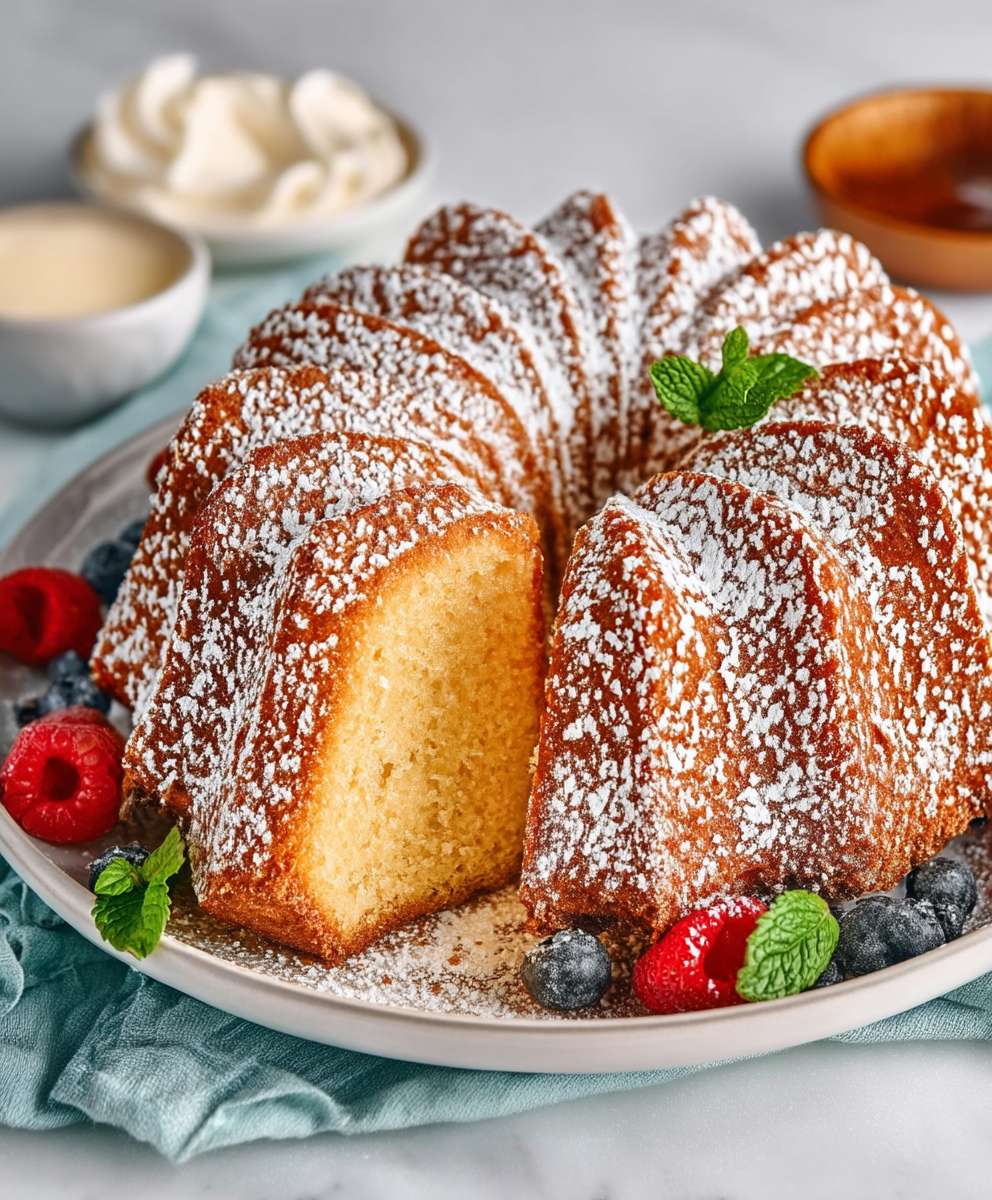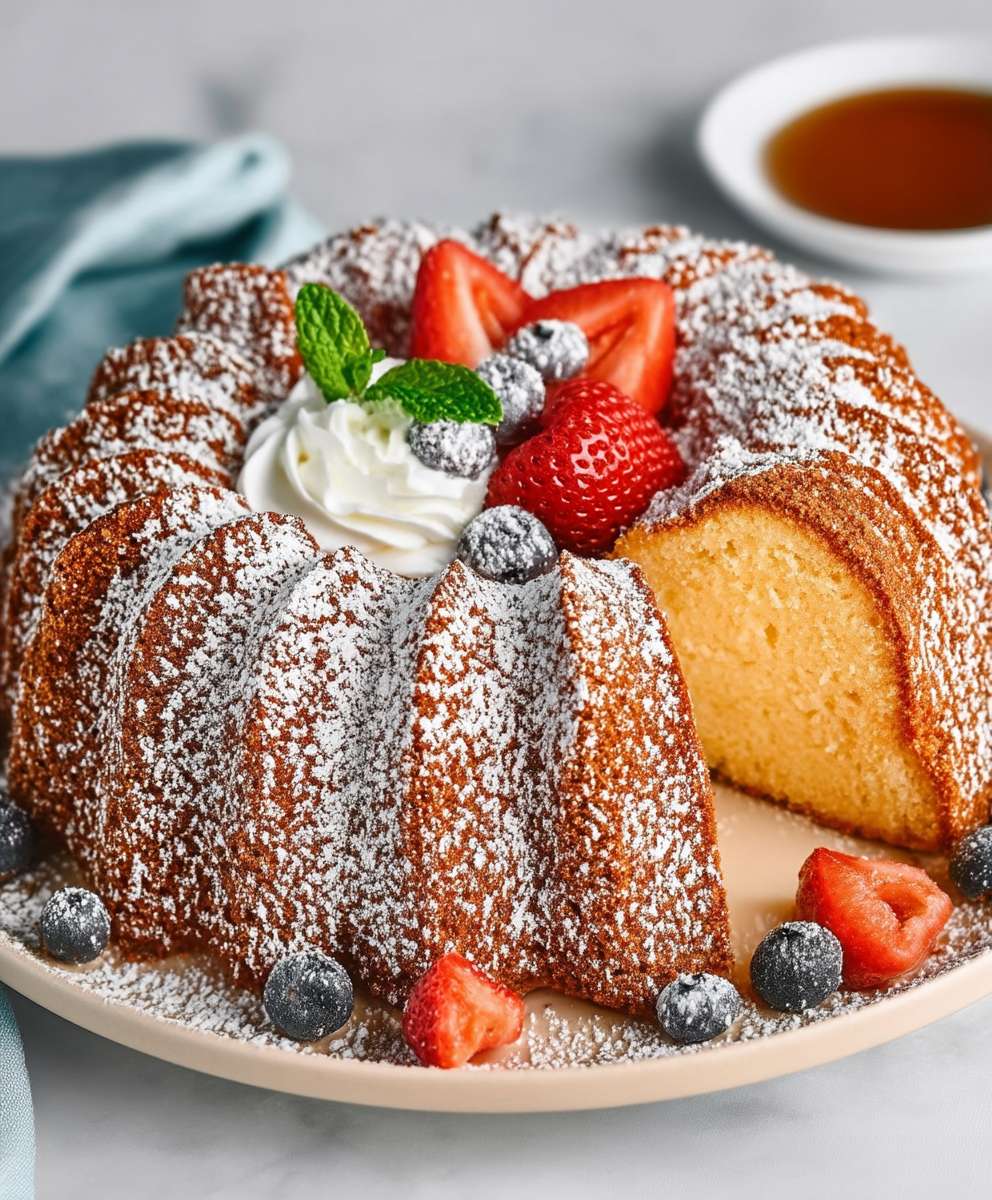Greek Yogurt Pound Cake: Prepare to be amazed by this incredibly moist and flavorful twist on a classic dessert! Forget everything you thought you knew about pound cake; this recipe elevates it to a whole new level of deliciousness. Imagine a cake so tender it practically melts in your mouth, with a subtle tang that perfectly complements its rich, buttery flavor.
Pound cake, a simple yet satisfying treat, has a long and storied history, dating back to 18th-century England. Its name comes from the original recipe, which called for a pound each of butter, sugar, eggs, and flour. While our Greek Yogurt Pound Cake recipe modernizes this classic, it retains the comforting essence that has made it a beloved dessert for generations. The addition of Greek yogurt not only enhances the moisture but also adds a delightful lightness that prevents the cake from feeling heavy.
People adore pound cake for its simplicity and versatility. It’s perfect on its own with a dusting of powdered sugar, or dressed up with fresh berries and whipped cream. But what truly sets this Greek Yogurt Pound Cake apart is its exceptional texture and taste. The Greek yogurt creates a tender crumb and a subtle tang that balances the sweetness perfectly. It’s a guaranteed crowd-pleaser, easy to make, and utterly irresistible. Get ready to experience pound cake perfection!
Ingredients:
- 1 ½ cups (3 sticks) unsalted butter, softened
- 3 cups granulated sugar
- 6 large eggs
- 1 teaspoon vanilla extract
- ½ teaspoon almond extract (optional, but adds a lovely depth)
- 3 cups all-purpose flour
- ½ teaspoon baking powder
- ½ teaspoon baking soda
- ½ teaspoon salt
- 1 cup plain Greek yogurt (full-fat or low-fat both work, but full-fat yields a richer cake)
- Zest of 1 lemon (optional, for a bright citrus note)
Preparing the Batter:
- Cream the Butter and Sugar: In a large bowl (or the bowl of your stand mixer), cream together the softened butter and granulated sugar until light and fluffy. This usually takes about 5-7 minutes on medium speed. Don’t rush this step; it’s crucial for incorporating air into the batter, which will result in a tender cake. Scrape down the sides of the bowl occasionally to ensure everything is evenly mixed.
- Incorporate the Eggs: Add the eggs one at a time, beating well after each addition. Make sure each egg is fully incorporated before adding the next. This prevents the batter from curdling. If the batter does appear to curdle slightly, don’t panic! Adding a tablespoon of flour from the measured amount can help bring it back together.
- Add the Extracts: Stir in the vanilla extract and almond extract (if using). These extracts enhance the flavor of the cake and add a subtle complexity.
- Combine Dry Ingredients: In a separate medium bowl, whisk together the flour, baking powder, baking soda, and salt. Whisking ensures that the baking powder and baking soda are evenly distributed throughout the flour, which is essential for a consistent rise.
- Alternate Wet and Dry Ingredients: Gradually add the dry ingredients to the wet ingredients, alternating with the Greek yogurt. Begin and end with the dry ingredients. So, add about one-third of the dry ingredients, then half of the Greek yogurt, then another third of the dry ingredients, then the remaining Greek yogurt, and finally the last third of the dry ingredients. Mix on low speed until just combined. Be careful not to overmix the batter, as this can develop the gluten in the flour and result in a tough cake. Overmixing is a common mistake, so err on the side of undermixing. A few streaks of flour are okay at this stage.
- Add Lemon Zest (Optional): If using, gently fold in the lemon zest. This adds a bright, refreshing flavor to the cake.
Baking the Cake:
- Prepare the Pan: Preheat your oven to 325°F (160°C). Grease and flour a 9×5 inch loaf pan. You can also use baking spray with flour. Make sure to coat the pan thoroughly to prevent the cake from sticking. Alternatively, you can line the bottom of the pan with parchment paper, leaving an overhang on the sides for easy removal.
- Pour Batter into Pan: Pour the batter into the prepared loaf pan and spread it evenly.
- Bake the Cake: Bake for 65-75 minutes, or until a wooden skewer inserted into the center comes out clean or with a few moist crumbs attached. The baking time may vary depending on your oven, so start checking for doneness around 60 minutes. If the top of the cake is browning too quickly, you can tent it loosely with aluminum foil.
- Cool the Cake: Let the cake cool in the pan for 10-15 minutes before inverting it onto a wire rack to cool completely. Cooling the cake in the pan allows it to set and prevents it from crumbling when you remove it.
Making the Optional Glaze (While the Cake Cools):
While the cake is cooling, you can prepare a simple glaze to drizzle over the top. This is optional, but it adds a touch of sweetness and visual appeal.
Glaze Ingredients:
- 1 cup powdered sugar
- 2-3 tablespoons milk (or lemon juice for a tangier glaze)
- ½ teaspoon vanilla extract (optional)
Glaze Instructions:
- Combine Ingredients: In a small bowl, whisk together the powdered sugar, milk (or lemon juice), and vanilla extract (if using) until smooth. Add more milk or lemon juice, one teaspoon at a time, until you reach your desired consistency. The glaze should be pourable but not too thin.
- Drizzle over Cake: Once the cake is completely cooled, drizzle the glaze evenly over the top. Let the glaze set for a few minutes before slicing and serving.
Tips for Success:
- Use Room Temperature Ingredients: Using room temperature butter, eggs, and Greek yogurt is crucial for creating a smooth and emulsified batter. Room temperature ingredients combine more easily and create a more stable emulsion, which results in a tender and evenly baked cake.
- Don’t Overmix: Overmixing the batter develops the gluten in the flour, which can result in a tough cake. Mix the batter until just combined, and don’t worry about a few streaks of flour.
- Measure Accurately: Accurate measurements are essential for baking success. Use measuring cups and spoons specifically designed for baking, and level off the ingredients carefully.
- Check for Doneness: The baking time may vary depending on your oven, so start checking for doneness around 60 minutes. Insert a wooden skewer into the center of the cake; if it comes out clean or with a few moist crumbs attached, the cake is done.
- Cool Completely: Allow the cake to cool completely before slicing and serving. This prevents it from crumbling and allows the flavors to develop fully.
- Variations: Feel free to experiment with different flavors and add-ins. You can add chocolate chips, nuts, dried fruit, or different extracts to customize the cake to your liking. You can also use different types of yogurt, such as flavored yogurt, but be sure to adjust the sugar accordingly.
- Storage: Store the cake in an airtight container at room temperature for up to 3 days, or in the refrigerator for up to 5 days. You can also freeze the cake for up to 2 months. Wrap it tightly in plastic wrap and then in aluminum foil to prevent freezer burn. Thaw the cake overnight in the refrigerator before serving.
- High Altitude Adjustments: If you live at a high altitude, you may need to make some adjustments to the recipe to prevent the cake from collapsing. Try reducing the sugar by 1-2 tablespoons and increasing the flour by 1-2 tablespoons. You may also need to increase the baking time slightly.
- Troubleshooting: If your cake is dry, it could be due to overbaking or using too much flour. Make sure to measure the flour accurately and check for doneness frequently. If your cake is dense, it could be due to overmixing or using cold ingredients. Make sure to use room temperature ingredients and mix the batter until just combined. If your cake is sinking in the middle, it could be due to underbaking or opening the oven door too frequently during baking. Make sure to bake the cake until it is fully cooked and avoid opening the oven door unnecessarily.
Enjoy your delicious Greek Yogurt Pound Cake!

Conclusion:
This Greek Yogurt Pound Cake isn’t just another recipe; it’s a gateway to effortless baking bliss. The moist, tender crumb, the subtle tang from the yogurt, and the beautifully browned crust all combine to create a pound cake that’s truly unforgettable. I know, I know, I’m biased, but trust me on this one! You absolutely have to experience this for yourself.
What makes this recipe a must-try? It’s the simplicity, really. We’re talking about a handful of ingredients, minimal effort, and maximum flavor payoff. Forget complicated techniques and finicky measurements. This recipe is designed for success, even if you’re a baking novice. Plus, the Greek yogurt adds a healthy-ish twist, making it a treat you can feel a little less guilty about indulging in.
But the best part? The versatility! This Greek Yogurt Pound Cake is a blank canvas for your culinary creativity. Serve it warm with a scoop of vanilla ice cream and a drizzle of honey for a classic dessert. Or, slice it thinly and toast it for a delightful breakfast treat. Feeling fancy? Top it with fresh berries and a dollop of whipped cream.
Here are a few serving suggestions and variations to get you started:
* Lemon Glaze: Whisk together powdered sugar, lemon juice, and a touch of lemon zest for a bright and tangy glaze.
* Chocolate Chips: Fold in a cup of chocolate chips (milk, dark, or white your choice!) for a chocolatey twist.
* Berry Swirl: Swirl in a berry compote (raspberry, blueberry, or strawberry) before baking for a beautiful and flavorful cake.
* Almond Extract: Add a teaspoon of almond extract to the batter for a nutty aroma and flavor.
* Citrus Zest: Incorporate orange or lime zest for a zesty and refreshing cake.
* Spiced Cake: Add a teaspoon of cinnamon, nutmeg, or cardamom for a warm and cozy flavor.
* Grilled Pound Cake: Slice the cake and grill it for a smoky and caramelized treat. Serve with grilled fruit and ice cream.
* Pound Cake French Toast: Use slices of the pound cake to make French toast for an extra decadent breakfast.
Don’t be afraid to experiment and make it your own!
I truly believe this Greek Yogurt Pound Cake will become a staple in your baking repertoire. It’s perfect for any occasion, from a casual weeknight dessert to a special celebration. It’s also a wonderful gift to share with friends and family.
So, what are you waiting for? Preheat your oven, gather your ingredients, and get ready to bake the most delicious pound cake you’ve ever tasted. I’m confident you’ll love it as much as I do.
And now for the most important part: I want to hear about your experience! Did you try the recipe? Did you make any variations? What did you think? Share your photos, comments, and feedback in the comments section below. I can’t wait to see your creations and hear your thoughts. Happy baking!
Greek Yogurt Pound Cake: The Ultimate Moist & Delicious Recipe
Moist and tender Greek Yogurt Pound Cake, perfect for any occasion. This classic cake is easy to make and can be customized with lemon zest or a simple glaze.
Ingredients
- 1 ½ cups (3 sticks) unsalted butter, softened
- 3 cups granulated sugar
- 6 large eggs
- 1 teaspoon vanilla extract
- ½ teaspoon almond extract (optional)
- 3 cups all-purpose flour
- ½ teaspoon baking powder
- ½ teaspoon baking soda
- ½ teaspoon salt
- 1 cup plain Greek yogurt (full-fat or low-fat)
- Zest of 1 lemon (optional)
Instructions
- Cream Butter and Sugar: In a large bowl, cream together softened butter and sugar until light and fluffy (5-7 minutes).
- Incorporate Eggs: Add eggs one at a time, beating well after each addition.
- Add Extracts: Stir in vanilla extract and almond extract (if using).
- Combine Dry Ingredients: In a separate bowl, whisk together flour, baking powder, baking soda, and salt.
- Alternate Wet and Dry Ingredients: Gradually add dry ingredients to wet ingredients, alternating with Greek yogurt. Begin and end with dry ingredients. Mix on low speed until just combined.
- Add Lemon Zest (Optional): Gently fold in lemon zest (if using).
- Prepare Pan: Preheat oven to 325°F (160°C). Grease and flour a 9×5 inch loaf pan.
- Pour Batter into Pan: Pour batter into prepared pan and spread evenly.
- Bake the Cake: Bake for 65-75 minutes, or until a wooden skewer inserted into the center comes out clean.
- Cool the Cake: Let the cake cool in the pan for 10-15 minutes before inverting it onto a wire rack to cool completely.
- Make Glaze (Optional): Whisk together powdered sugar, milk (or lemon juice), and vanilla extract (if using) until smooth.
- Drizzle over Cake (Optional): Once the cake is completely cooled, drizzle the glaze evenly over the top. Let the glaze set for a few minutes before slicing and serving.
Notes
- Use room temperature ingredients for best results.
- Don’t overmix the batter.
- Measure ingredients accurately.
- Check for doneness with a wooden skewer.
- Cool completely before slicing.
- Store in an airtight container at room temperature for up to 3 days, or in the refrigerator for up to 5 days.
- Can be frozen for up to 2 months.
- High altitude adjustments may be needed.






Leave a Comment